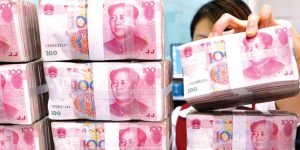Bloomberg
China’s central bank took further steps to limit the yuan’s strength, a day after policy makers made their most substantial move yet to rein in the currency’s surge against the dollar.
The People’s Bank of China (PBOC) set its daily yuan fixing at the weakest relative to estimates since Bloomberg began publishing the forecasts in 2018. The fixing came hours after the PBOC told banks to hold more foreign exchange in reserve, a move that effectively reduces supply of dollars and other currencies onshore and puts pressure on the yuan to weaken. Still, it continued to strengthen in
onshore and offshore markets.
Together the moves present the market with further signals that Beijing is wary of rapid gains in the exchange rate, given traders can unwind long positions just as quickly. Earlier this week the yuan advanced to its strongest level against the dollar since May 2018, with confidence boosted by official signals of more easing to support the economy.
Authorities “don’t want too sharp an appreciation in a soft period,†said Ken Cheung, chief Asian FX strategist at Mizuho Bank. The PBOC needs to send a strong signal at a time when markets become more bullish and Federal Reserve has taken a more hawkish tone, he added.
The PBOC has told banks to hold more foreign currencies in reserve for the second time this year, prompting the offshore yuan to drop to its lowest level this month. The currency is set to be Asia’s best performer against the dollar this year, bolstered by strong inflows from robust exports and foreign investment in onshore bonds. On a trade-weighted basis, the yuan is hovering near the strongest level since 2015.
Year-end currency settlement flows would likely be supportive of the yuan, United Overseas Bank strategists said, noting that the PBOC’s move to hike the FX reserve requirement ratio would reduce onshore
liquidity of foreign currencies.
The moves give a clear signal that authorities are seeking to draw a line under the yuan’s strength, and the currency may retrace towards 6.40 versus the dollar where it could stabilise, said Khoon Goh, head of Asia research at Australia & New Zealand Banking Group Ltd.
The large deviation in yuan fixing relative to forecasts also raises questions as to whether the PBOC has quietly re-enabled the counter-cyclical factor, a tool last used in October 2020 that gives Beijing more influence to curb one-way moves in the yuan. Today’s weaker fixing could be due to its reintroduction if it wasn’t due to a one-off “reset,†Khoon said. Alvin Tan, head of Asia FX strategy at RBC Capital, said he suspects that the PBOC reintroduced the factor in daily fixing in September.
If the bump up in US dollar cost of funding isn’t a large enough deterrent for speculators, other tools are available to the central bank, Citigroup strategists said. They could include further increases in forex reserve requirement, lowering the short-term foreign debt ceiling, US dollar buying intervention and re-introduction of FX forward risk reserves.
 The Gulf Time Newspaper One of the finest business newspapers in the UAE brought to you by our professional writers and editors.
The Gulf Time Newspaper One of the finest business newspapers in the UAE brought to you by our professional writers and editors.
